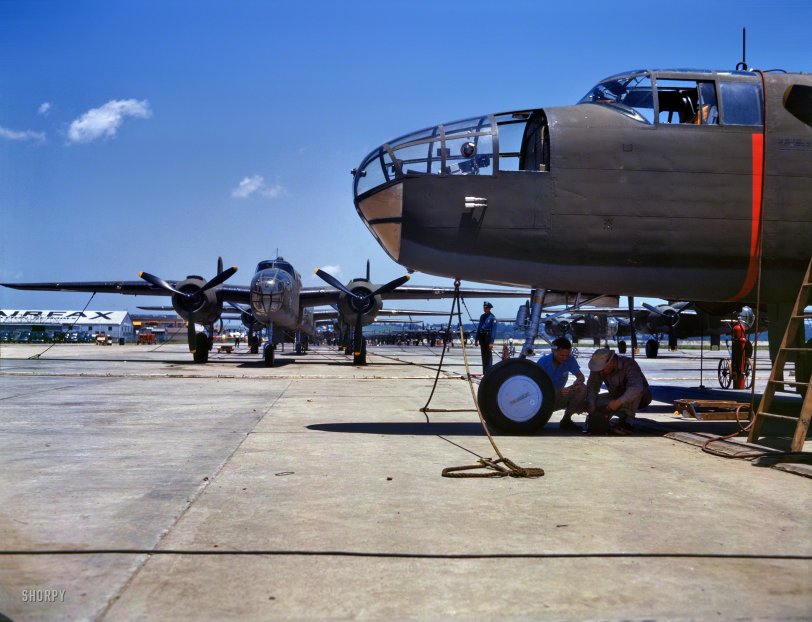


Framed or unframed, desk size to sofa size, printed by us in Arizona and Alabama since 2007. Explore now.
Shorpy is funded by you. Patreon contributors get an ad-free experience.
Learn more.

- Famous hollywood faces
- Not just S&P
- re: Those things in the jar
- Up In Smoke
- Medical Smoking
- Quick fix
- A Quink Comment
- If You’re Like Me, Never
- Delivering the News
- U.S.A.
- S&P
- 1940 Zenith radio model 6G601
- Quality goes in before the name goes on!
- Snazzy skirt
- Carbon Arc Lamps
- Illuminate us
- I remember it well
- I can't prove it
- Complicated then, forgotten now
- Bryan-Stevenson
- Skinny is as skinny does
- How do you rest in peace
- Riding the footboards
- Alas, hidden from view
- Baldwin Diesels
- Exclusive pump
- Bananas, Oysters and Smokey Joe
- Details, Details
- What's that building to the left of the tower?
- Coal Barges
Print Emporium
Hatchlings: 1942

October 1942. "New B-25 bombers lined up for final inspection and tests at the North American Aviation plant in Kansas City, Kansas." 4x5 Kodachrome transparency by Alfred Palmer for the Office of War Information. View full size.
From nothing to nest in 9 months
This photo is probably looking north; most of the buildings at the Fairfax airport were on the west side of the property.
There is a lot of history on the North American plant (and the Fairfax airport) here. Some highlights...
The airport opened in the early 1920s as Sweeney Airport. It was renamed Fairfax Airport in 1928. (Note the Fairfax Aviation Schools sign on the building at the left.) The ground-breaking ceremony for the North American Aviation plant was held on 8 March 1941, and the first B-25 came off the line on 23 December 1941, a couple of weeks after Pearl Harbor. They didn't stop making B-25s there until the day after V-J Day.
GM bought the bomber plant and built their first car there in June 1946. The airport flooded in 1951, like a lot of the rest of Kansas City; that was part of the reason for building Mid-Continent International way up north of town. GM kept building cars there until 1987, and tore down the plant in 1989. The airport was in service until 1985. GM bought the whole airport and built a new plant pretty much right on top of the center of the runways a few years later. You can still see some of the runways on aerial photos.
The North American (and later GM) plant was located at what is now the north end of Fairfax Trafficway, at Kindleberger Road. I remember it being there when I visited the area as a kid. When I worked in the area in the early 1990s, there were still a few of the airport buildings there, even though the new GM plant was already up and running. By the late 1990s all the airport buildings were gone.
Note that this is *not* Downtown Airport in Kansas City, Missouri (MKC), which is still there and operating.
Easy to Appreciate
The skill that was required to take off from the deck of 'Shangri-La' in one of these beautiful planes.
My uncle owned 3 of these planes during his life
I had an uncle who owned 3 of these planes,two at one time back in the 70s(before he married my aunt).There was a feature article done back in the 70s in one of the local papers about him and the two planes that he owned back then.He later sold one of those two planes and traded the other one to the Yankee Air Force in Ypsilanti,Michigan for the third plane that he had until he sold it(and two semi trailers full of parts) a couple of years before his death.That one,named "Guardian of Freedom" now resides in Califonia in the collection of General William Lyons.
I never got a chance to ride in the plane,darn it.
Electric Ice Boxes and Razor Blades
"Don't worry, the Americans can't build planes, only electric ice boxes and razor blades" -- Hermann Goering.
Re: Remarkable Speed
At the height of production, the Ford Bomber plant at Willow Run, Michigan turned out one completed bomber every hour. Pretty impressive!
B-25's
Some B-25 models did indeed have solid noses; this was to accommodate multiple machine guns (and on some models a 75 mm cannon). These were used in a ground attack role and to attack shipping. Obviously by eliminating the bombardier's position bombing accuracy was lessened as the pilot had to aim and drop the bombs "by guess and by golly".
Many actions
Used in all theaters of WW II most notable the Dolittle raid on Tokyo made six months before this photo.
Re: Love!
Your grandfather probably flew one of the hundreds of variants of the B-25. Over 10,000 of them were produced during the war and there were tons of variants. Most were bombers, some were recon planes, others were modified for specific bombing missions (such as the Doolittle Raid). I'm at work or otherwise I'd try to dug up a few photos of variants with enclosed noses.
Hope that helps a little!
Mundane but impressive
This is such a simple scene, but it speaks to the remarkable speed with which factories turnout all sorts of machinery during the war.
Love!
My grandfather flew these in the Pacific in WWII, one named Vera that I have a full-frame photo of on my wall, but the bow wasn't glass, but fully enclosed. But the photo was from later in the war, so I wonder if the eventually enclosed them? Hmmm...
























On Shorpy:
Today’s Top 5